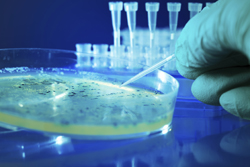Bacterial reproduction without a cell wall
The bacterial cell wall is a crucial external layer outside of the cell membrane. These cell walls are made from polysaccharide chains cross-linked by specific bacterial peptides. Most bacteria are capable of changing into a cell wall-deficient (CWD) L-form state. Many L-forms are antibiotic resistant and are associated with a wide range of infectious diseases. Typical L-form cells are spherical. Bacterial cell division usually requires a cell wall and components of the bacterial cytoskeleton. The ability of L-form bacteria to grow and divide in the absence of both of these structures may represent a type of cell division that was important in early forms of life. The 'Characterisation of factors involved in proliferation of Bacillus subtilis L-forms' (CFILP) project investigated the mechanisms of L-form proliferation in the bacterial model Bacillus subtilis. Project researchers isolated and studied genetic mutations promoting cell division and proliferation in the absence of a cell wall. They found that the key mutations for L-form proliferation induce the production of excess cell membrane through activation of the fatty acid synthesis system. Furthermore, an artificial increase in the cell surface area / volume ratio in wild type L-forms resulted in the spontaneous formation of the progeny cells. Using a gene inactivation approach, investigators identified a mutation that prevented cell division of L-forms capable of proliferation. They isolated the mutation implicated in the synthesis of a fatty acid component of the cell membrane. The main phenotype observed in this mutant was a reduction in cell membrane fluidity. The reduced membrane fluidity blocked L-form proliferation at a membrane scission step, preventing the release of progeny cells. A final model of L-form division suggests that unbalanced growth generates an increase in cell surface area, which leads to spontaneous shape deformation. This disequilibrium between surface area and volume can be corrected by progeny formation (division) if the membrane is sufficiently flexible. CFILP results provide direct support for the idea that purely biophysical effects could have provided an efficient mode of proliferation in primitive cells before the evolution and development of the cell wall.







